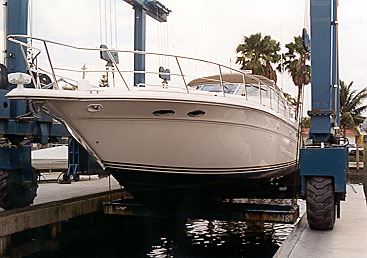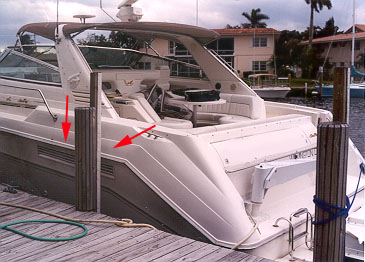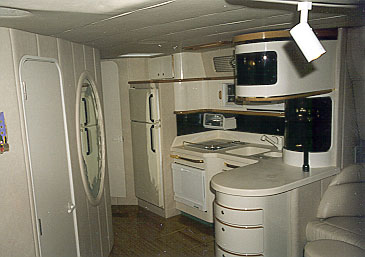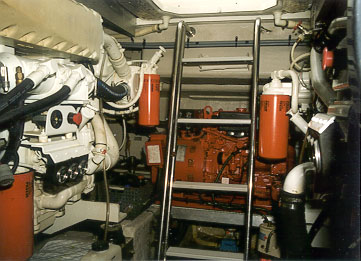Sea Ray 500
by David Pascoe

| LOD: | 50'1" | Weight: | 34,500 lbs advertised |
| Beam: | 15'0" | Generator: | Westerbeke 8.3kw |
| Draft: | 4'0" | Engines: | Cat 3176, 600 hp, |
| Twin Disc MG5112 vee drive |
This is the second of this model we've examined and sea trialed within several months, one being a 1998 model and the other a 1996. There were few differences between the two except that one had a swim platform extension and the other did not. Also that the earlier model had a blistered bottom whereas the later one didn't. This was surprising because blistering on Sea Rays has been a rare occurrence of late.
THE HULL Banging around on the bottom of this boat gave the overall impression of solidity, hardness and thickness. In this age of "advanced composites," we no longer look at a molded boat and call it "fiberglass," for the fact is that in this age of "advanced composites" we no longer know what boats are made of, nor can we go chopping them up to find out. However, the one thing that can be said about this one is that, unlike so many boats, this one gave off no sense that it is suffering from a lack of structural strength, even after bashing one of them around pretty good out in the ocean.
While we can't see much on the internal hull, we did get a few peaks at the stringers in the forward section. These are very tall -- usually around 18" and sometimes more -- and were revealed to have a core of three, 3/4" plywood, for a total thickness of 3-1/2 inches. The stringers were well encapsulated in chopped strand matt (at least on the visible surface), and were very heavily gel coated. There wasn't any indication that they'd suffer from water penetration and deterioration as is known to happen in the past.
The hull sides were equally solid, and displayed no indication that they'd be subject to panting or deflection under pounding conditions. Indeed, we did get the opportunity to test this out in rough water conditions. Observation revealed that the four port holes on each side were neither fluttering or leaking. The bulkheading throughout seems to be adequate, though it's pretty
The only place we got a look at the hull-to-deck join is in the rope locker where through bolts could be seen. However, this bolting may only be for extra strength for the bow pulpit that constitutes a tremendous lever arm in this area. Sea Rays have been notorious for poor-hull-to-deck joins that break open and cause serious leaks, as well as loose rub rail problems. Unfortunately, we couldn't confirm how the entire deck was secured. In fact, problems were brewing back aft around the engine room vents which consist of large, rectangular cut outs that are located much, much too close to the deck joint. Here we found that very minor impacts had caused permanent insets at the hull/deck join, including buckling of the aluminum vent grills and distortion of the rub rails. This is clearly illustrated in the photo below.

Stylistic ideas here make boarding even at this ideal dock a problem. The arrows point to the design of the engine room vent that makes the hull/deck join very weak. Damage already exists of both sides of this boat.

While the galley area is spacious, counter space is minimal. Note that there is a sea rail around the stove top so that pans of boiling liquid don't come flying off to send you to the hospital after that unexpected wave hits.
THE DECKS That gigantic expanse of foredeck did not reveal any problems. The deck is obviously cored, though we don't know with what material, yet there's not a trace of weakness, unlike we've often found on some of the smaller models such as the 320 Sundancer. You can jump on this one without the whole boat shuddering or feeling like you're on a trampoline.
I very much like the non-skid texture used here -- it's like a paint roller pattern that is easy on bare feet and knees. Though it won't absolutely stop your feet from slipping, I find it preferable, and much easier to clean than sharper patterns. With those diamond patterns, one can get gummy substances stuck in the grooves that is very, very difficult to remove. After the survey, when we'd mucked the boat up all over with our dirty foot prints from the boat yard, the captain took no more than thirty minutes cleaning it up and washing it down.
The stainless handrails are remarkably sturdy, as is the curved stainless windshield containing REAL glass, no plastic to get all scratched and checked. Keep in mind the cost differential between molded glass and plastic, and the fact that no one every splurges to cost of replacing worn out plastic, while the glass is good indefinitely. The small, electric center vent window is nice, too. Of course it leaks a little, but the extra ventilation outweighs this drawback in hot climates at least.
At four years old and no evidence of recent polishing, the gel coat is holding up fairly well. At least there's no chalking and some shine is left on the horizontal parts.
THE COCKPIT Well, this one doesn't exactly thrill me. Too cramped and cluttered for my taste, but I understand well that many people like it, so to each his own. Fitted with a radar arch (they call it a spoiler, leaving me to wonder what it's spoiling) it allows for a nicely fitting Bimini with removable soft panels all around. This is one of the few that looks like it was designed to make the top fit right. And it does.
The seating upholstery is now attached to thick, plastic bottom panels that eliminate a good part of the rot problem that we had with plywood bases. However, it does not prevent the upholstery from absorbing a ton of water and causing other bad things to happen. These cushions still need to be removed and stood on end when not in active use. Do that and everything will be fine and dandy.
Access to the foredeck is adequate. One can get up there fairly quick without feeling like one the Flying Wallendas or Harry Houdini. There's no excuse for it being otherwise on a boat this large, yet that's exactly the problem on the yet larger Sea Ray 55. The big ergonomic buggaboo on this one is cockpit entry. Sitting at the dock, which was 28" above the water, it was not possible to climb over the side of the cockpit without a ladder or steps. Instead, you had to, like a gymnast, stretch your leg waaay out to step onto the swim platform and enter by the transom door. This was not easy, in fact it was dangerous, and you're surely gonna have a problem taking grandma along. In most cases, a special boarding arrangement will be necessary. On the plus side, at least there was a built in cockpit step on the interior on the port side, none on the starboard. At least you don't have to walk on the furniture to get aboard like with some boats. Yet for what I thought was an ordinary level dock, boarding is a problem.

The engine room is very deep and needs this ladder. Unfortunately, it is in the way of everything. Once you climb down, you have to remove it to get at anything back there.
Placement of major items allows for pretty easy service access.
THE INTERIOR It's a typical Sea Ray interior, a bit too slick and far too much plastic for my taste, especially considering the price that has taken a few giant steps lately. Though I will say that the quality has gone up over the years, at least from the standpoint of fit and finish, and probably overall durability. The number of aggravating little things that fall apart has declined dramatically, at least in this model. Gaining my appreciation was a reduced amount of foam rubber/vinyl padding and/or wall coverings, though there's still plenty of it.
It was noted that there is no wood decking in the galley area, as we've found on other larger models, and instead imitation wood vinyl flooring. Makes more sense than a hopelessly and permanently stained wood floor.
A two stateroom layout, the guest has large upper and lower berths with more than adequate floor space. But while the master stateroom has adequate deck area. the berth is squarish with the pointy ends orientated fore-n-aft. Even so, with that broad, spoon-billed bow, there was still no side entry to the bed, so that one has to crawl on hands and knees to go to bed. Well, if you don't like that, you probably will like the generous sized bathrooms, aka heads, that consist largely of easy clean fiberglass liners with the Vacuflush head system that works fine and doesn't stink up the interior. Never mind that the holding tanks weren't being used. That's a story for another day.
Farthest aft is a 2/3rds circular lounge couched a bit back up under the cockpit deck, with a smallish, round pedestal table in the center. My first and last impression was "Why?" It's a pretty well known fact that people don't like to scrunch themselves into difficult to escape seating arrangement like this, never mind with elbow-to-elbow proximity. And while there's plenty of space, I felt this area could have been put to much better use. The good news is that it wouldn't cost all that much, or be very difficult, to rip it out and rearrange it to one's own pleasure.
There were no leaks on either of these two boats. Not one, despite the good bashing we gave them. On the '98 model we took tons of spray over the bow, so we would have found them if there were any.
Modular molded head units are THE way to go. So easy to keep clean and hold up well.
ENGINE ROOM Altogether, the spatial layout is not bad, and there are no serious maintenance drawbacks. Most everything can be reached fairly easily, so the do-it-your-selfer isn't going to find this boat a backbreaker. Without too much difficulty, one can go fully around the engines without killing themselves. Over 200 pounders need not apply. I had no complaints with the installation of things, nor the general quality level of components in general. The designers had their heads on straight here. There are even air vent filters (aluminum mesh) to help cut down on salt intake. And no, there wasn't oily bilge water sloshing over the decking, decking that is frequently non-existent on smaller models.
In both cases, the shafts were fitted with Strong seals that seem to be holding up well.
I wish we could say the same for the Cat engines, but in the '98 model, the heads had already been off and a lot of bolts turned on these engines. No engine history was made available so we don't know what the story is here, but would presume it's the same old cylinder head problem. To make matters worse, the starboard engine started to overheat and cut our sea trial shorter than we'd liked, an engine with only 364 operating hours and two years old.
Okay, so now we don't have Detroit Diesel to kick around anymore. We got Caterpillar and MAN. You folks who think high performance diesel engines run for 5000 hours, 3000 hours, or even 2000 hours without major cash infusions, dream on.......if you want to go fast, it's going to cost you dearly.
As with the DDEC systems of Detroit Diesel, Caterpillar is now providing modular instrument clusters. That's all well and good, but for those of you guys who were always complaining about the cost of replacing separate instruments, wait until one of these little beauties craps out. The invisible hand grasping upon your wallet becomes increasingly sophisticated as time marches by.
PERFORMANCE Unlike many of the Sea Ray expresses that I've criticized in the past for having engines placed too close together, which results in rather poor maneuverability, that's not the case here despite the propeller pockets. The rudders are noticeably enlarged so that docking is reasonably easy. We've noticed quite a few people putting bow thrusters in these boats, but that is really not necessary if you get someone to teach you how to operate the boat correctly.
I'm going to do something here that I don't usually do, and that is to compare two boats of same size and general design, and yet are radically different in other aspects. I'm going to put the Sea Ray 500 up against the Magnum 50 which we have also tested recently. It's almost like apples and oranges, I know, because the hull designs and vessel weights are so different.
The reason I make this comparison is to illustrate the some of the compromises that you make when you chose a boat that is designed for spaciousness versus a design for performance. Or when you choose style over practicality. Keep in mind that it the boat buyer's tastes that ultimately lies behind the design of the most popular boats. So we can't heap all the blame on Sea Ray here. Like every other builder, they try to give buyers what they want.
The Magnum weighs in at some 50,000 lbs with Detroit Diesel 8V92s and 25 degree deadrise, while the Sea Ray is much lighter at 34,500 lbs advertised weight with a 19 degree deadrise plus propeller pockets.
Our sea trial weather.
With 1700 hp the Magnum is a much faster boat (45 knots) than the Sea Ray at 1200 hp and 31 knots. In one case we took a 50 Magnum from Ft Lauderdale to Miami in the face of an approaching hurricane. Inshore seas were highly variable and confused, but generally around 5-6 feet in shallow water as we had to hug the coastline to avoid 12 footers out in the stream. For the Sea Ray, we had a stiff southeasterly over deep water kicking up a fresh set of three footers. Mind you, these were honest three footers that the average Joe would probably describe as 5 foot.
Even at 23 knots cruise speed, the motion in the Sea Ray was very unpleasent at any point of attack except abeam the seas. Everyone had to hold on for dear life. At WOT it was all you could do just to hold yourself in position. One could not let go of a solid handhold -- as I did -- without being thrown off your feet and into a heap somewhere in a corner. I'm still sprouting a large bruise on the side of my head where I got thrown into the radar arch that angles into the cockpit (which it shouldn't, for safety reasons) even while I was holding on. At full speed, it was virtually impossible for an ordinary person to go down into the cabin. I did, and I got bounced between the overhead and cabin sole several times because there is virtually nothing to hold on to down there.
The Magnum was a completely different experience under conditions that were doubly bad. Now, I'm not going to sit here and tell you that the ride of the Magnum was smooth as silk because it wasn't. But it was notably lacking in the degree of violent movement encountered in the Sea Ray. The very heavy weight, combined with the deep vee, combined with a much more pointy bow, accounts for the difference. Because of the weight and narrower entry, when the Magnum hits a wave, that wave has far more difficulty in causing a violent movement of the boat. The hull had more of a tendency to slice through the wave, without being thrown high into the air, taking the passengers with it.
The weakness of the SeaRay is its lightness combined with that spoon billed bow that offers a very large surface area to the waves. The boat hits the wave and it's the boat that goes flying, whereas the Magnum cuts through it. Of course, people aren't buying Magnums in droves like they are Sea Rays because they don't have the cavernous interior spaces that the Sea Rays do. The favorable hull shape precludes that. And no, we could not go slamming at 45 knots into 6 foot seas. We were doing about the same 24 knots as the SR but with a much more comfortable ride, albeit just as wet. In both cases, we were drenched in salt water.
The point here is to demonstrate the vast differences that can exist between two similar style boats. There is much discussion these days about light weight, high speed and fuel economy, yet if one looks closely most such discussions omit any consideration for what kind of weather one is operating in. If the sea conditions in your area area always calm with rarely 3 foot seas, then you'll have no complaints about the Sea Ray. Indeed, the vast preponderance of fast boats these days are light weight, relatively flat bottomed jobs that have to stay tied to the dock when the wind blows. It was no accident that the only other boats we saw out on the ocean during our sea trials were Bertrams and Hatterases, and there were both blasting along with relative disregard for the sea conditions. The Magnum 50 will handle 3 footers much the same, whereas everyone aboard the SR was clamoring to get the hell back in port before someone got hurt (which I did).
Yeah, the Sea Ray tops out at 31 knots and cruises 24-25 knots, but not in weather like this.
SUMMARY Overall, it's a well built boat with a significant degree of practical design features. Many of our previous gripes about SR boats are not present here, with the probable exception of the deck join and rub rails situation. While I wouldn't call it an exclusively cocktail circuit cruiser, I'm reluctant to say that it would make much of a serious cruising boat. Its inability to handle even moderate seas with an acceptable ride precludes that. Its ideal home is in protected lakes, bays and other waterways, but is ill at ease with oceanic conditions.
On the resale market in the years ahead we can expect this one to hold up fairly well physically, and should account for good, overall value. Indeed, at 3-4 years old, they're going at times for less than half original cost. We will point out that we found at least 50 of this model listed for sale at similar asking prices. The obvious question is, why so many? For the new boat purchasers, the handwriting is on the wall. For used boat buyers, be sure that rough water performance meets your expectations.
Posted February 5, 2000
 Visit davidpascoe.com for his power boat books
Visit davidpascoe.com for his power boat books 














David Pascoe is a second generation marine surveyor in his family who began his surveying career at age 16 as an apprentice in 1965 as the era of wooden boats was drawing to a close.
Certified by the National Association of Marine Surveyors in 1972, he has conducted over 5,000 pre purchase surveys in addition to having conducted hundreds of boating accident investigations, including fires, sinkings, hull failures and machinery failure analysis.
Over forty years of knowledge and experience are brought to bear in following books. David Pascoe is the author of:
In addition to readers in the United States, boaters and boat industry professionals worldwide from nearly 80 countries have purchased David Pascoe's books, since introduction of his first book in 2001.
In 2012, David Pascoe has retired from marine surveying business at age 65.
On November 23rd, 2018, David Pascoe has passed away at age 71.
Biography - Long version